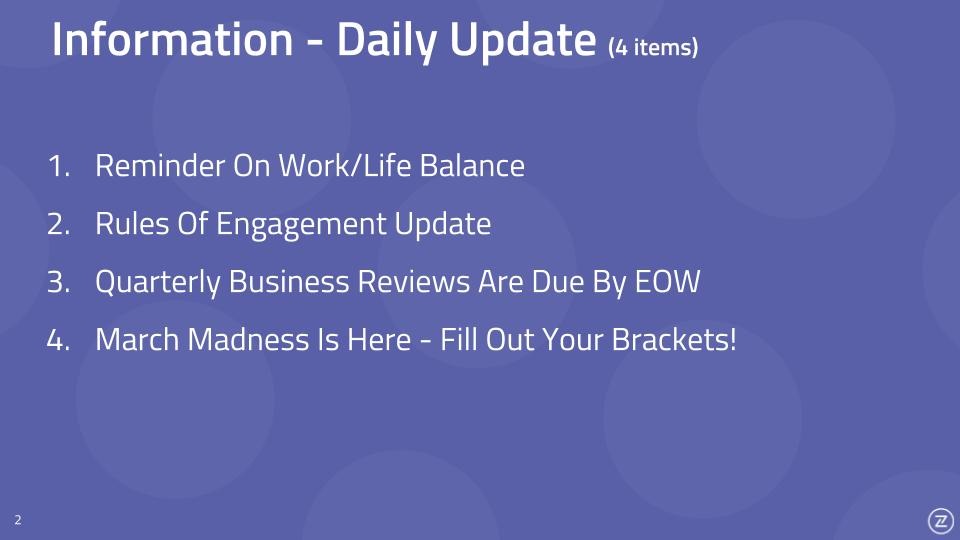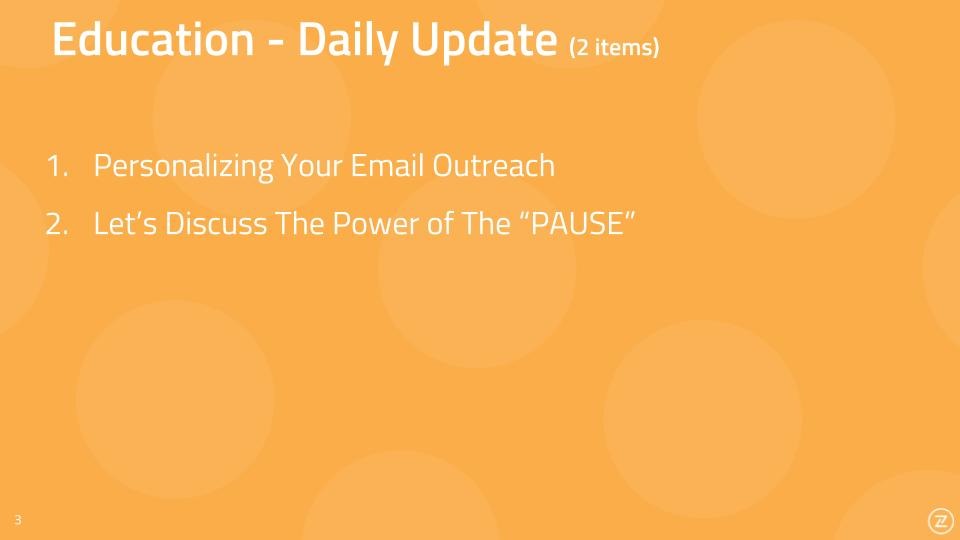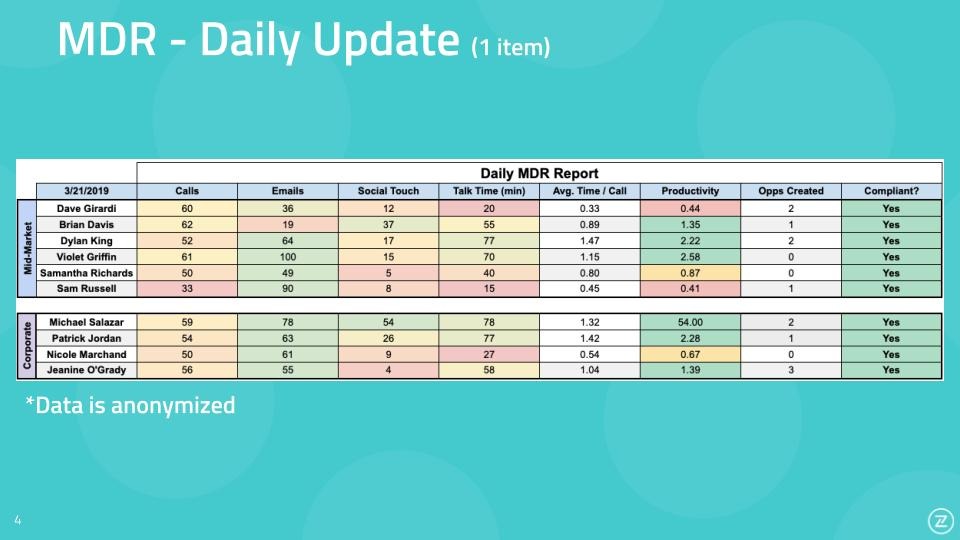Common interactions typically include the monthly or weekly 1-on-1, sales kickoffs, weekly sales team meetings, and the quarterly performance review. I believe the most impactful meeting you can have with your sales team is the sales huddle.
What is a Daily Sales Huddle?
A daily sales huddle (also known as a stand-up meeting) is a mandatory meeting that is held every day with the entire sales team. These daily meetings are used to achieve four primary goals:
- Communicate business updates
- Reinforce training
- Provide accountability for activities
- Motivate the team to succeed
Daily sales huddles are best used with teams that are judged on activity metrics such as dials, emails sent, social touches, or talk-time. This could include BDR/SDR teams, full-cycle transactional sales teams, or corporate and mid-market account executives that still need to build their own pipeline.
Who Should Run the Daily Huddle?
To make sure there’s consistent accountability for an effective meeting, I recommend that a team lead, Manager, or Director should take the helm of these meetings. Since huddle meetings are run every day, it can be challenging to have someone at a VP level or above run them. That said, there’s nothing wrong with the occasional “guest host” if the usual leader is unavailable.
When Is the Best Time To Run A Daily Sales Huddle?
I think it’s best to run a sales huddle first thing in the morning. Why? If you’re doing it right, the huddle should inspire and motivate the team to start the day strong. Plus, an early morning meeting cuts into prime selling hours less.
If anybody shows up after 9:00 AM, they’re not allowed to join the meeting. The meeting is too important to allow distractions like people entering the room after we’ve begun.
And quite honestly, this is a wonderful side benefit to running a sales huddle every single day: it ensures everyone shows up on time (or at least attempts to). I’ve found that sales reps secretly like having a highly structured daily routine and the daily sales huddle is a fantastic way to promote team cohesiveness and personal accountability.
If you choose to run your stand-up meetings later in the day, you might run into these problems:
- Meeting attendees are distracted by work they have already begun.
- What little progress is made during the meeting only affects the little remaining time in the work-day.
- The discussion may be forgotten by the following morning when work begins again.
How Long Should Daily Huddles Be?
I recommend 30 minutes for a stand-up meeting. I’ve found it’s the perfect amount of time to cover my “I Earn Real Money” meeting agenda (I’ll get into details on that later).
I’ve also heard of other sales leaders keeping their stand-up meetings to a 15-minute limit. Whatever meeting length you choose, never go past the time you’ve booked for the huddle. You will lose credibility as a leader and reps will lack respect for your daily meeting if you go longer than what was promised.
Where Should the Meeting Take Place?
Some people hold stand-up meetings in open-concept offices where the team literally just stands up at their desks. I don’t recommend that method if it can be avoided.
Privacy is good for the team. Not only does it make it easier for the meeting leader to candidly share information, but it also encourages members of the sales team to share more openly.
I have a conference room booked out on a recurring basis that’s large enough to hold my entire team. I also send out a calendar invite to each team member to make sure they don’t book any sales calls over our time together.
What is The Ideal Daily Huddle Agenda? (IERM – I Earn Real Money)
I like coming to work early and using the extra time to prepare the content for my daily sales huddle. If you’re not a morning person, save time at the end of each day to prep for the next morning’s meeting.
Preparation is key to an effective meeting!
My prep is effective, but not fancy: I use a Google slides template. I update the deck every morning, then cast it to a screen in our conference room when the meeting starts. A presentation format more clearly and visually organizes the content and I’ve found it to be more impactful for the team.
In terms of what the slides contain, I use the mnemonic device “I Earn Real Money” to remind myself of: information, education, recognition, and motivation.
Agenda Item 1: Information
The information slide is where I’ll circulate any business updates that the reps need to be aware of. While not an exhaustive list, examples of information that can be disseminated might include:
- Creating urgency (i.e. days left to sell)
- Due-date reminders (e.g., business plans, surveys, etc.)
- Sales contest roll-outs or results
- Technology stack changes
- Welcoming new team members
- Upcoming company holidays
- Who’s on vacation
- HR policy updates
- Birthdays or work anniversaries
In our daily huddle last week, I reviewed these items with the team:

In any given daily sales huddle, I usually have between three to five informational bullets to review. I also occasionally use this section of the meeting to do an “icebreaker” or similar activity that could help the team learn more about each other and foster camaraderie.
Agenda Item 2: Education
In the education portion of the huddle, I focus on coaching to sales or systems processes. Due to the thirty-minute time constraint, you will likely not have enough time to cover more than two educational topics. I usually only review one.
Here’s an example from a recent huddle:

Other topics I’ve recently discussed include:
-
- Pulling a sales call recording and reviewing one key part (e.g., the intro, the close, etc.)
- Reviewing CRM or sales enablement tool best practices
- Live role-plays
- Writing great introductory emails
- Leaving voicemails that get returned
- Maximizing LinkedIn as a sales tool
- How to spot a great account
The educational slide is a wonderful opportunity to reinforce core sales processes and to ensure adoption through repetition. In fact, if a recent concept is new or is having difficulty gaining traction, I might even keep the same educational topic going throughout an entire week, and just cover it from a new angle each day.
Agenda Item 3: Recognition
At this point, you should have roughly ten to twelve minutes left in your meeting: just enough time to give kudos to those who have demonstrated the type of behavior that leads to consistent excellence.
For my business development team, that behavior is high activity.
On the recognition slide, I include a screenshot from our team’s activity dashboard. It’s simply a Google sheet that has active cells that pull from a Salesforce activity report – but of course, you can take a screenshot from any reporting tool, or show a live dashboard that suits your purposes.
In my dashboard, BDRs who hit their numbers the previous day are highlighted in green. Anybody who missed is highlighted in red.
Here’s what it looks like:

There is inherent accountability in this approach because no one wants to suffer the embarrassment of low activity and seeing their name in red. Likewise, there’s pride in knowing your name is always in green.
While displaying activity stats is recognition in and of itself, I’ll still proactively shout out those that went above and beyond. I might say something to the effect of:
“I want to give a special shout out to Sarah for having over 100 dials yesterday, crushing the phones and booking two demos. Let’s give a quick round of applause to Sarah, great job!”
Everyone in the room can also see the substandard performance on the screen, and addressing it with equal openness will help create a culture of “no excuses”. This is one of the main reasons why you should run a sales huddle every single day.
Agenda Item 4: Motivation
Every time I come across a motivational quote or meme on the internet, I save it in a folder on my desktop. When I get to the motivational slide of my huddle, I upload a piece of content from my folder that relates to the theme of the meeting.
I’ll then have one of my reps read it aloud and then explain what it means to them. Afterward, I’ll explain what it means to me and why I chose it for the day.
It’s nothing fancy, but it starts the day on a great note. Here’s a recent one I liked:

Sometimes, I also play a clip from a video or podcast or share a section of an article that helped me think in a new way. Basically, I’m always on the look-out for things that motivate and speak to me just so I can share them with my team.
This part of the meeting might seem superfluous or cheesy, but don’t skip it. It’s your chance to get your people thinking on a higher level and feeling good about the work they’re doing and why it’s important for your company and their career.
Ending The Meeting
If I have at least two or three minutes left, I’ll ask the room what they learned from the meeting, something they’re excited to try, or something that resonated with them. I usually ask for no more than three, and if no one raises their hand, I’ll force the issue and call on someone myself.
If I’m managing a remote team, the meeting is over after asking for takeaways. I’ll wish them good luck on the day ahead and we’ll sign-off.
If the meeting is in-person however, I like to end the meeting with a chant. The chants frequently rhyme and they always have something to do with one of the topics discussed.
For example, if the educational portion focused on overcoming objections, I might call out, “Don’t bail!”, with the reps responding with a hearty, “Make the sale!” We chant it three times, and then the meeting is officially over.
I like concluding daily sales huddles with a chant because it ends the meeting on a high-energy note and puts everyone in the right frame of mind to win more business.
My reps seem to like making a lot of noise at 9:30 in the morning as well!
Embracing The Sales Huddle
Some people that I’ve shared this format with in the past doubted they would have enough content to for a daily meeting. Collecting enough productive content for the meeting is a habit that takes time to build. Begin taking notes on the priority for the day each morning and you’ll find there are things you’d like to share with the team.
Even if you only come up with one or two new items each day, you can always keep bullets from previous meetings alive and ask the group for updates. Don’t do this just to hold a meeting, but instead to reiterate important points or ask your team for their latest thoughts on the subject.
They say it takes a village to raise a child. I believe it takes a sales team to raise a sales rep, and the daily sales huddle provides that opportunity. They give salespeople the chance to come together as a team in a constructive environment; they will engage with each other, they will learn from each other, and they will hold each other accountable.







